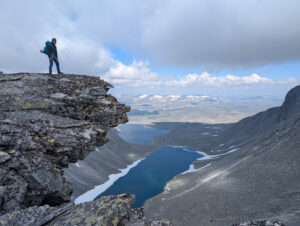How do you know you have the right person in the right place? And how do I identify those who possess the mental fortitude required for my bold, uncomfortable, and often high-risk expeditions to some of the world’s most remote and inhospitable mountains? One thing is clear: those joining me on my Himalaya expeditions must be eager to climb the mountain—not simply content to see it climbed for them.
In this article, I share my insights on recruiting for the most demanding assignments. Join me on an inspiring journey as we explore how to identify and build a team with the right mindset—a team that isn’t just able to overcome challenges but dares to push themselves to reach new heights.
By Fredrik Sträng
“Do you want to climb the mountain, or do you want it climbed?” – Fredrik Sträng
Adventurers Wanted – For Norway’s 377 Summits
Let me be clear: this is no ordinary hike.
My upcoming project—summiting Norway’s 377 peaks above 2,000 meters in one year—places extreme demands on its participants:
- 10–15 hours of climbing and trekking each day
- 15–30 kilometres covered daily, with up to 2,500 meters of elevation gain
- Razor-sharp mountain ridges with sheer drops on both sides
- Abysmal weather, swarms of mosquitoes, freeze-dried food, and heavy backpacks—day after day
Are you ready to take on such a challenge?
Most people might ask: Who would choose to subject themselves to this—and also pay for it!?
But this isn’t about unraveling life’s mysteries; it’s about the drive behind what we do. The legendary mountaineer George Leigh Mallory—who may well have been the first to summit Mount Everest back in 1924—perfectly captured this drive when he declared, “Because it’s there.”
Similarly, Joseph Campbell developed the theory of “The Hero’s Journey”, a narrative model that has influenced everything from literature to film—even inspiring George Lucas during the creation of Star Wars. Campbell emphasized the importance of following one’s bliss and embracing life’s challenges in the pursuit of meaning.
Perhaps this is where we can all agree: there are elements of existence that will forever elude our complete understanding. Yet, rather than be frustrated by this mystery, we can choose to be fascinated by the diversity of human nature—in which we may feel envy, awe, or inspiration. The key takeaway? Perspective is refreshing, and our ability to embrace it is essential for continuous growth.
When recruiting for this project, I look for those who genuinely love what they do. After all, the right candidates don’t just grow on trees. And let’s be honest—Match.com is probably better suited for leisurely forest walks (Type 1 Fun: enjoyable both during and after the experience) than for a project of this magnitude (Type 3 Fun: not fun at all—not even in hindsight).
I have received tremendous support from people captivated by what I plan to do in Norway. But let’s be clear: this is no comfortable stroll through woodlands and hills. It will be challenging, brutal, and demanding—just like the journey you embark on with your startup, the groundbreaking project you lead, or the transformation your company is currently navigating.
Entrepreneurship and Adventure – More Alike Than You Think
Entrepreneurship and adventure share surprisingly many parallels. We both navigate the unknown, confront a world in constant flux, and must quickly adapt to new rules.
In business, it’s about keeping pace with AI and automation. For me, it means reading weather changes, managing unforeseen risks, and making crucial decisions when everything is on the line. Regardless of the arena, success demands courage, flexibility, and a willingness to challenge oneself—especially where others hesitate.
Finding the right people for demanding expeditions has been a challenge since the dawn of humanity. Jared Diamond argues that the human exodus from Africa was strongly linked to geography and environment. Resource availability, climate changes, and the need to adapt drove Homo sapiens to spread across the globe.
In those early societies, there were two types of individuals:
- The Adventurers – those who ventured out to explore new hunting grounds and opportunities.
- The Preservers – those who built the community, safeguarded the group, and developed new survival strategies.
These roles still exist today—in research, innovation, and business. Some are pioneers, while others create stability and sustainability. Success requires both.
Building the Perfect Team
On a Himalaya expedition, the composition of the team is critical. To reach the summit, you need a balanced mix of individuals:
- The Young and Hungry: Brimming with energy, drive, and a relentless desire to push boundaries.
- The Experienced and Patient: Those who know when to hold back and strategize for the long term.
- The Stabilizers: The individuals at base camp who ensure that logistics work smoothly and that every climbing team has what they need.
The same principle applies to recruitment in the corporate world. It’s not solely about knowledge and experience—it’s about mental attitude, teamwork, and the ability to handle challenges. To build a team that can tackle extreme challenges, we must first pinpoint the key attributes—beyond technical expertise.
Adventurers Wanted – In the Spirit of Shackleton
It is said that Sir Ernest Shackleton, who attempted to traverse Antarctica on foot in the early 1900s, placed the following advertisement in a London newspaper:
“Men wanted for dangerous journey. Low wages, bitter cold, long hours in complete darkness. Safe return uncertain. Honor and recognition upon success.”
Legend has it that over 5,000 men—and three sporty women—applied. Only 28 were selected.
Here’s my own call for adventurers for my Norway project:
“Do you have the courage—or the madness—to take on the challenge? No salary. Icy winds. Long days filled with sweat, chafing, and extreme self-testing. Occasional bouts of doubt and existential crises. The reward? Uncertain. Honor? Perhaps. Eternal recognition? Probably not. But you will feel truly alive. So if you’re a life enthusiast with a hint of masochism who craves a genuine, beautiful, and damn adventurous experience—get in touch!”
And just as with corporate recruitment, the wrong candidates were quickly filtered out. Those looking for a comfortable nature experience bowed out, and individuals more focused on their own ambitions than the team’s success were eliminated.
The first question I always ask is: Do you want to climb the mountain—or do you want it climbed?
Recruiting Right – Insights from Both Research and Reality
A survey conducted by the recruitment firm Manpower in Sweden offered an unexpected insight into people’s dream jobs. Ten thousand men and women were asked what their dream job was. Women ranked “adventurer” as the third most desired profession, while for men it took the top spot.
What lies behind these answers? Is it a longing to escape the bland and predictable—to break free from a routinized life? If that’s the case, then why is it so astonishing that when I ask a different question:
Do you want to climb the mountain—or do you want it climbed? A staggering 95% respond that they’d rather have the mountain climbed.
Many dream of adventure, but very few are willing to undergo the grueling process required to achieve the goal. Physical challenges, fears, and long-term strain scare most away—just as they do in the business world when lofty visions collide with reality. It is one thing to want to be part of something great, but it is an entirely different matter to endure the arduous journey to get there.
The same principle applies when I recruit individuals for my expeditions. I immediately filter out those who start discussing the benefits they expect before even mentioning what they can contribute and how they intend to drive the project’s success.
I vividly remember one person who reached out to me even before I advertised my Norway adventure. She described how essential this challenge was for her personal growth, how it would offer her a fresh start, how she truly needed this experience. Yet, not a word about how she could contribute—no mention of how her experience and skills might bolster the project’s success.
That is precisely how effective recruitment works—whether for expeditions or in the corporate world. It is not about those who simply dream of the goal—it’s about those who are prepared to endure the journey to achieve it.
Seeing Beyond the Surface – When My Father Promoted “a Difficult Bastard”
My father was the CEO of Rosengrens in Mora and Malung during the 1990s—a company that manufactured safes. Under his leadership, the business experienced remarkable growth: employee satisfaction increased, profitability improved, and sick leave decreased.
Yet among the staff was one individual widely regarded as a problem. He was grumpy, frequently complained, and cast a negative atmosphere. No one had anything positive to say about him.
Rather than getting frustrated or simply dismissing him, my father did something unexpected—he looked deeper to understand what was truly wrong.
After reviewing his CV, he realized that the man was well-educated yet relegated to trivial tasks. Perhaps the lack of challenge rendered him frustrated and disengaged?
My father saw beyond the attitude and identified the core issue. He chose to promote him—from a disgruntled employee to a department manager.
The change was immediate. He carried himself differently, spoke differently, took responsibility, and brought order to the workshop. He transformed into a leader—and suddenly, he was no longer viewed as that problematic person but earned genuine appreciation.
The staff marveled, “What did you do?”
All my father did was put the right person in the right place. He looked beyond the surface and recognized that the real challenge wasn’t the man himself—it was that his potential had never been properly tapped.
A Lesson for HR and Managers
Recruiting and retaining the right people isn’t merely about filling a vacancy. It is about understanding people’s motivations, strengths, and needs. Sometimes, a “difficult bastard” is simply a misaligned talent. How many unpolished diamonds lie within your organization, waiting to shine—if only given the right opportunity?
Understanding One’s Role – A Lesson from Mount Everest
It was 2005 when I first set foot on Mount Everest. We climbed from Tibet, and in our team was a kitchen boy named Pemba.
His task was simple yet vital: for nearly two months, eight hours a day he would journey to a nearby glacier, chip off ice, haul it back to base camp, and melt it. Why? So that we would have water—to drink, to cook with, for washing dishes, and for bathing.
Despite the monotonous and demanding work, Pemba never complained. He always smiled, standing there with immense pride in his duty, cheerfully remarking, “Cooking snow, very nice!”
One day, I approached him and asked, “How come you are always so positive when you are melting the ice?”
He leaned in, as if about to reveal a great secret, and smiled before answering, “I have the most important job!”
Curious, I pressed further, “What is it, Pemba?”
With the same warm smile, he replied, “Without water, everyone will die.”
I couldn’t help but smile in return. Here was someone who loved his job—day in, day out. He would never be featured atop Everest, nor would his name grace a front page or attract reporters’ interviews—but he carried his role with profound pride and insight.
Lesson for HR and Managers
That is precisely how it should be in every organization. Employees must understand how their contributions fit into the larger picture; otherwise, work becomes a series of mechanical tasks devoid of meaning.
It reminds me of the classic story of the two stonecutters: When a passerby asks the first stonecutter, “What are you doing?” he replies, “I’m cutting stone and piling the finished blocks beside me.” Then the passerby asks the second stonecutter the same question, and with pride he answers, “I’m building a cathedral!”
Recruiting the right people is about more than just competence. Whether it’s for expeditions or the business world, it’s crucial to find individuals who see the bigger picture—those who value their role as an integral part of something greater.
So, how do you ensure that your employees feel they’re building a cathedral—and not merely cutting stone?
Follow Along Over the Coming Year – And Let Yourself Be Inspired!
1st of July marks a turning point. This is my comeback as a professional adventurer. Over the next year, I have set an audacious goal that few dare to dream of: to summit Norway’s 377 peaks above 2,000 meters.
My mission? To awaken your wild side. To remind you that life isn’t meant to be lived from the couch—it is meant to be experienced fully, boldly, and with an open heart. I hope to ignite that fire within you, to inspire you to lace up your boots, feel the wind on your face, and chase your own summits.
Throughout the coming year, you can follow my journey as I report daily from the expedition and share my most powerful insights on:
- ✅ How to turn failures into success
- ✅ How to think, act and behave like a winner
- ✅ Why we overestimate what we can accomplish in a day but underestimate what we can achieve in ten years
- ✅ How complaining rarely solves problems—and how you can shape the outcome instead
- ✅ And above all: that mountains don’t get any less steep just because we complain
Why is this important?
We live in an age where we shy away from resistance, opting for instant comfort over long-term progress. Yet humans are built for challenges. A muscle grows stronger through resistance. Our psyche is fortified by trials. We need regular doses of both physical and mental stress to build resilience, courage, and true satisfaction.
I have dedicated my life to inspiring and motivating others. Now, I need some inspiration too. Follow me over the coming year—and book a lecture with me this fall when I take a break from climbing to share my insights with you and your team!
Are you ready to take on your own mountains and find those who are willing to join you on the journey?
————————————-
About Fredrik Sträng: In his leadership role, Fredrik has summited seven of the world’s fourteen 8,000-meter peaks, holds a Guinness World Record, and lectures on workplace joy, leadership, communication, decision-making, and crisis management. He is a two-time TEDx speaker, has authored two books, and produced documentaries for National Geographic, Discovery, TV4, and SVT. He also guides companies—taking them, for example, on expeditions to Kebnekaise.
Best regards, Fredrik Sträng
Mountaineer – Speaker – Coach







